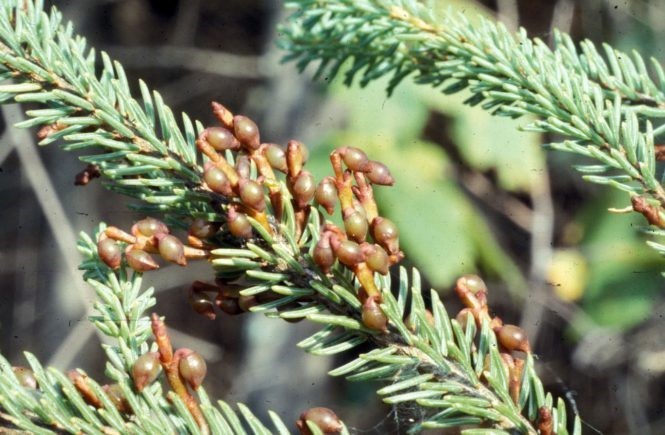You don't want to be underneath this mistletoe: the Eastern Spruce Dwarf Mistletoe
by Fred Baker, Emeritus Professor and Forest Pathologist, Utah State University
Eastern spruce dwarf mistletoe is a disease that kills trees quickly, with most trees dying within 20 years. In Minnesota, this mistletoe typically affects black spruce, an important species to the state's forest products industry and landscape.
The dwarf mistletoe disrupts a tree's physiology in incredible ways. The most common sign is the formation of a witches' broom. In this process, the disease diverts the tree's nutrients to the broom and "starves" the rest of the tree. Ultimately, the tree will die because it's unable to process the lipids it needs to survive.
Witches brooms in a dwarf mistletoe-infested black spruce stand. Photo: Brian Anderson.
Dwarf mistletoe is a parasite. It flowers in March and is a safe bet to be the first "plant" to flower in the spring. Seed dispersal happens in late August and early September. When seeds disperse, dwarf mistletoes are unique because they can shoot their seeds up to 55 feet from a diseased tree! These seeds are covered with a sticky substance that attaches to a nearby spruce needle. During summer rainfall, this sticky substance rehydrates, and the seeds slide closer to the twig, where it germinates the following spring.
Although dwarf mistletoe can shoot seeds up to 55 feet, most only go a few feet. This results in a spread rate of about 2.4 feet per year through a forest stand. Research indicates that spread from large trees and small trees is about the same. Slightly more than half the spruce stands in Minnesota are thought to be infected with dwarf mistletoe.
Mistletoes are obligate parasites. This means that if you kill the tree, the parasite dies too. If timber harvesting is done in black spruce, removing all spruce trees during a harvest could minimize the risk of mistletoe infecting a future stand.

